Japanese otaku fans are often associated with two controversial concepts: lolicon and moe. Outside of otaku circles, both terms are associated with some sort of abnormal attraction for fictional characters. To put it bluntly, they are perceived as two equivalent forms of perverse sexuality. The goal of this article will not be to prove or disprove this: the argument over whether or not otaku are pedophiles does not interest me, and my general view on the matter is that such a debate is largely fruitless. What I’d like to do here is different, although it could shed some light and context on the debate.
My aim is double: on the one hand, it is to show that otaku engagements with fictional characters are more complex than generally believed; on the other, it is to follow their evolution and explain that lolicon and moe are closely related, but not identical. Understanding them as two historical structures of otaku culture that overlapped and followed each other will allow me to illustrate those links and differences.
To that end, I will go over the origins of both, and follow decades of otaku culture, from the 1970’s to the 2000’s. This will not be a comprehensive overview, and my most important bias will be to focus exclusively on male, heterosexual otaku. This isn’t to say that they are the only representatives of otaku culture; but, as it is mostly with them that lolicon and moe are generally associated, it is only their history that I will retrace.
Like our content? Feel free to support us on Ko-Fi!
The origins of lolicon
As is well known, the word lolicon is short for “lolita complex”, from Vladimir Nabokov’s novel Lolita and the subsequent 1966 essay The Lolita Complex by Russell Trainer. As Patrick Galbraith says, these are dangerously “familiar terms” [Galbraith 2019, p.21], but they are hardly relevant to understand the lolicon otaku movement, especially since Trainer describes a behaviour coming from young girls towards older men, whereas in the otaku’s case, it is from (older) men to (fictional) young girls.
Any study of lolicon must therefore begin in the early 1970’s, a period which saw the quick development of shoujo manga, and especially shoujo written by women – those called the “Year 24 Group” comprising artists such as Yasuko Aoike, Moto Hagio, Riyoko Ikeda, Keiko Takemiya and many others. With their work, shoujo manga fandom quickly developed, as the example of the Comic Market shows: the most important doujin market in Japan was created by (and largely for) Moto Hagio fans.
It is from shoujo fans that the word “lolicon” first started to appear in otaku-related circles. Indeed, Patrick Galbraith managed to retrace the first use of the word: “the first appearance of the words ‘Lolita Complex’ (rorita konpurekkusu), which would be combined in the Japanese portmanteau ‘lolicon’ was in a shoujo magazine. In the June 1974 issue of Bessatsu Margaret, in a work titled Stumbling Upon a Cabbage Patch […] which draws heavily from Alice in Wonderland, a male character describes Lewis Carroll as a man with a Lolita complex, or someone with the ‘strange character of liking only small children.’” [Galbraith 2019, p.28]
However, Galbraith goes further and theorizes that Shinji Wada, the (male) author of the work in question, “was sharing an inside joke with ‘male’ shoujo fans.” [p.28] To put it shortly, Galbraith’s argument is that “lolicon” was initially a word male shoujo fans used to refer to themselves. Indeed, as shoujo manga developed, so did its audience, and more and more men started reading them. But such a taste for “girly”, “childish” or “cute” works would have been frowned upon at the time, especially by other manga fans who prefered dark gekiga or science-fiction stories that were developing at the same time. These fans therefore developed a strong sense of community, and “lolicon” was one of the key words they used to refer to each other. However, during most of the 70’s, these fans were still a minority: the Comiket was mostly attended by women, while most male fandoms were oriented towards science-fiction. It is only around 1979 that things began to change and that lolicon became more mainstream, thanks to two artists: mangaka Hideo Azuma and director Hayao Miyazaki.
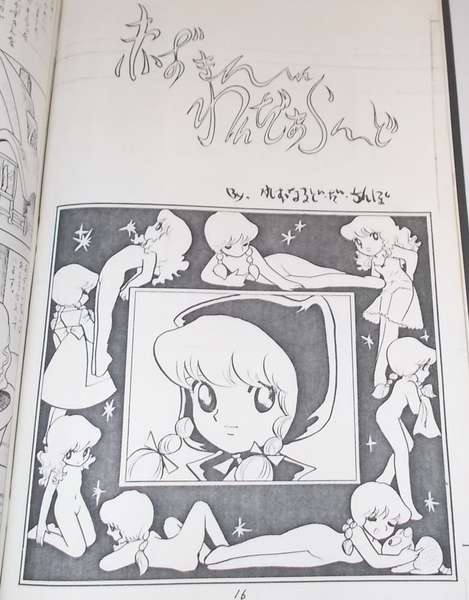
The cover of Azuma’s Little Red Riding Hood parody in Cybele #01
It is in 1979 that Hideo Azuma, one of the first major male shoujo manga artists, published the first Cybele doujin, which notably contained an erotic parody of Little Red Riding Hood. What stood out was not the erotic content of the manga, but rather the art style, which combined round, cute characters inspired by Osamu Tezuka and a search for expressivity and emotion inspired by shoujo manga. In Azuma’s own words, he was pursuing a kind of “cute eroticism” (kawaii ero) [p.31] which would become, as I will show, the central theme of the lolicon aesthetic.
Azuma’s works in the 70’s had always been preoccupied with sexuality, and in that, they were a clear response to both male-oriented gekiga productions and female-oriented shoujo. Both were counter-cultural forms that sought to revise the perception of sexuality: gekiga went for realism and grittiness in order to break societal taboos about sex, while many shoujo represented gay love stories. Azuma wanted to do something different from both, and look for eroticism even further, that is in so-called innocent, children’s manga, such as those by Osamu Tezuka. What was at stake was therefore not so much the representation of child sexuality, but rather, as Patrick Galbraith expresses it, a question of genre and gender dynamics:
“Faced with the overwhelming presence of girls and women at the Comic Market, and the dominance of fanzines by and for girls and women focusing on sexual and romantic relationships between male characters, Azuma and his friends were opening space for boys and men. In fact, even as Azuma was responding to shoujo manga in his bishoujo manga, lolicon fanzines were responding to yaoi fanzines by and for girls and women. If imagined and created relations with, between, and through male characters provided girls and women with space to more flexibly play with gender and sexuality, Azuma and his friends raised the possibility of something similar for boys and men.” [p.33]
It is in this context that Hayao Miyazaki released his first feature-length movie: Lupin III, The Castle of Cagliostro. Under normal circumstances, this movie would have had nothing to do with shoujo and lolicon fans: the original manga was dark and macho, and even if the eroticism had been toned down in animated adaptations, it was clearly not made to appeal to shoujo sensibilities. But Miyazaki had his own vision of the franchise, especially of Lupin’s character: initially a brutal and violent criminal, he became a much nicer person, taking on the role of a “protective older brother” [Crawford 2020].
This new interpretation of the character was mostly made possible thanks to Lupin’s interaction with the movie’s original character: the young girl Clarisse. Rose Crawford explained in detail the originality and appeal of Clarisse’s character: “she was the stark opposite of Fujiko Mine, a major player in the Lupin III franchise, a classical femme fatale who carried all of Lupin’s wits and tricks herself. As well, while damsels existed in all genres of manga, especially children’s manga, none of them were as accessible nor as character-driven as Clarisse. She was in peril with high stakes around her survival. Castle of Cagliostro‘s audience was compelled to care for Clarisse and want to protect her […].” [Crawford 2020]
The movie caused (and still causes) many debates among Lupin fans for its disrespect to the original franchise and characters. But regardless of this, Clarisse appealed to the audiences and very quickly became an icon. Just months after the movie had come out, doujin such as Clarisse Magazine or Clarisse Symphony started to appear.
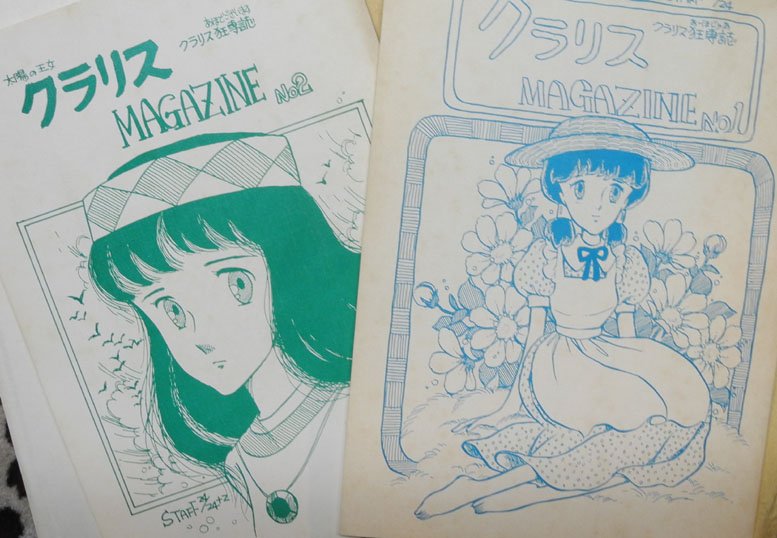
The first two issues of the Clarisse Magazine
Azuma and Miyazaki’s works represent the two sides of the lolicon phenomenon, what I’d call the “dark” and the “bright” one. Azuma rooted it in doujin culture, but most importantly in erotism or pornography: it is no doubt from him that the long-enduring image of “children sexualization” comes from. On the other hand, Miyazaki’s approach is more comfortable and sympathetic: it is an attraction for girl characters based not on any eroticism, but on their absence from it. Clarisse is innocent and pure, and it is precisely what compels the viewer to like and want to protect her. The entanglement of those two sides would be the trigger of the “lolicon boom” and would definitely constitute lolicon not just as a fandom movement, but as an aesthetic of its own.
Lolicon and the bishoujo aesthetic
A major common point between Miyazaki’s and Azuma’s characters, besides the fan activity they triggered, is their very nature: the fact that they are beautiful young girls, ie bishoujo. In that regard, it is telling that, while the words “lolita” and “loli” were already in circulation, the most common word used to refer to attractive female characters was rather bishoujo which does not especially refer to a child. On the contrary, while “lolita” implies a prepubescent girl, shoujo or bishoujo point to an often minor girl that is precisely at the age of discovering her sexuality – from around 13 years old up until the mid-20’s. Childishness and cuteness were therefore determining elements, but age was never the primary consideration – which did lead to the inclusion of prepubescent characters into the bishoujo category. Galbraith expresses roughly the same idea when he says that “the orientation of the cute movement, of lolicon, was not toward the girl per se, but rather the shoujo, or girl character, and the bishoujo, or cute girl character, specifically.” [Galbraith 2019, p.21]
In any case, by the early 1980’s, the “lolicon boom” had started in earnest, but it quickly grew very different from its humble beginnings in the male shoujo fandoms. In February 1982, the first official lolicon magazine, Lemon People, started coming out, and it quickly faced hard competition from the likes of Manga Burikko, Melon Comic, and many others. The actual content of these magazines is interesting, because it translates the tension between the “dark”, pornographic side of lolicon and the “bright”, bishoujo-oriented one. Lemon People, which mostly featured works from Hideo Azuma and his group, published parodic doujin, often but not necessarily of erotic or pornographic nature. The most interesting aspect is that, initially, the magazine included idol photographs; but due to reader demands, it quickly switched to manga only: real bishoujo didn’t interest lolicons, but only fictional characters.
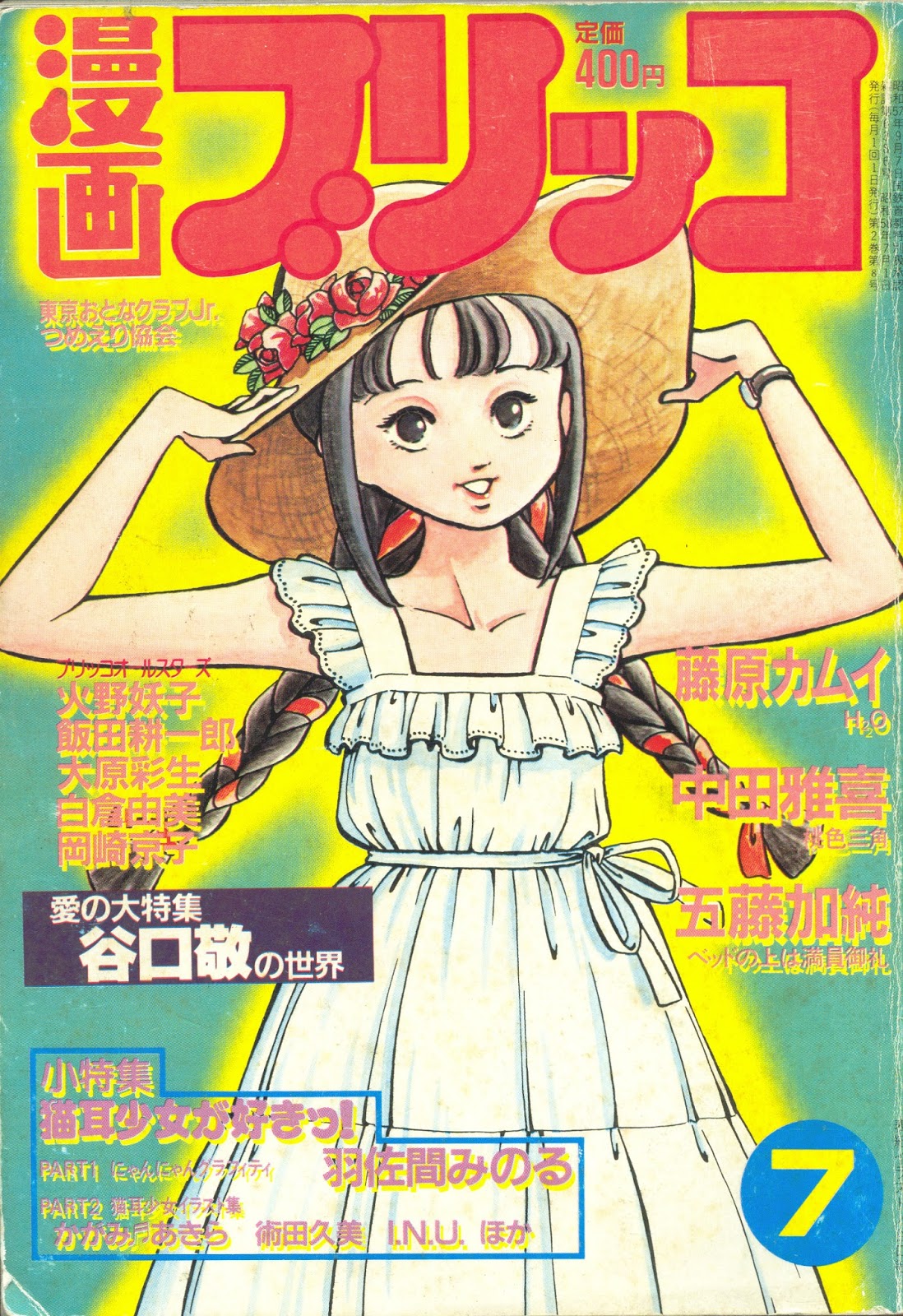
A 1983 issue of Manga Burikko
As for Manga Burikko, it initially started as a true erotic magazine: in the words of Patrick Galbraith, initially, “it looked more like an adult gekiga magazine carrying gag strips and pornographic comics.” [Galbraith 2019, p.40] It was in 1983 that, under the influence of Eiji Otsuka (who had also been editor at Lemon People), the magazine changed focus and started publishing male and female shoujo manga artists. Just like in Lemon People, photographs progressively disappeared, and the content itself began to change: the “transformation further included a move away from explicit depictions of sex. In Manga Burikko, as it transformed into a flagship of the genre, lolicon appears as a departure from photographs and hard sex in the realistic style of gekiga and a move toward soft, light and cute eroticism in the style of shoujo manga.” [p.42]
Such magazines were the core of early 80’s otaku culture: it was, after all, in the columns of Manga Burikko that Akio Nakamori coined the term not to refer to anime fans, but to men that identified as lolicon. Quickly, there was no more difference between an anime fan, an otaku, and a bishoujo fan: take for example the two Daicon shorts. Although they played a large part in the invisibilization of the shoujo manga fandom in favor of SF fans, they also prominently featured a bishoujo character and direct references to Azuma’s works. By 1983, the shoujo origins of the movement had been largely forgotten. Instead, male fans wholeheartedly accepted bishoujo characters and started integrating them in SF narratives such as Macross, Gundam or Gunbuster.
If lolicon spread like wildfire both in mainstream and less mainstream otaku media, its core principles remained the same: bishoujo characters, and the paradoxical idea of “cute eroticism”. I believe that one of the artists most representative of these aspects is Toshihiro Hirano. Indeed, Hirano is probably one of the most important actors of the lolicon boom, at least in its animated version. He played a part in all the major steps of lolicon’s evolution: his first success was as animation director on Macross in 1982, and it is said that it is his art that made Linn Minmay popular in the first place. Just after that, he contributed to some episodes of Urusei Yatsura, the foundational love comedy of anime and manga history. After that, in 1984, he directed an episode of Cream Lemon, one of the most important pornographic anime, did the character designs of Megazone 23, one of the very first OVAs, and then debuted as a director on Fight! Iczer One in 1985.
Iczer One is significant because it shows so well how blurry the lines were between “regular” OVA production and porn. It was a 3-episode anime, but what made it special was that all pilots were bishoujo, that there were basically no male characters and that it was adapted from a manga that had run in Lemon People. Everything was therefore directed towards the female characters, and Hirano put all his talent as a designer in making them as erotic and cute as possible with their big eyes and plump bodies, but also their short skirts and skin-tight clothes. Iczer One is excuding sexuality, whether because of the abundance of panty shots, the lesbian characters or the constant threat of tentacle rape. But at the same time, there are no explicit sex scenes, and the heroine Nagisa is constantly presented as cute and innocent.
The link to sexuality and pornography was therefore always very present, but never always the prominent focus. That is because, above all, lolicon wasn’t a genre (as you might say, “this is a lolicon anime”), or even a particular relationship to characters (falling in love or sexualizing young girls). It was an aesthetic that revolved first around cuteness, and eventually eroticism. This explains why magical girl shows which initially didn’t target the otaku market ended up hallmarked as flagships of lolicon: they were cute, and that was all that was needed. What mattered was not the content, but simply the character designs and appearances: they were childish and round, and therefore appealing. They were, basically, kawaii. Once it had been divorced from its shoujo manga origins, lolicon became just that: an otaku-inspired, sexualized take on cuteness.
The crisis of lolicon and the emergence of moe
Although it had been flourishing during all the 1980’s, the lolicon boom came to a sudden and unexpected halt in 1989, with the arrest of Tsutomu Miyazaki. The young man had murdered and raped four young girls aged from 4 to 7, and after his arrest, the mass media found stacks of VHS tapes and pornographic magazines, many of them lolicon anime and manga. The presence and content of those is still hardly debated, as there are many suspicions that most anime tapes were in fact planted by journalists; later analyses of Miyazaki’s collection revealed that it was not abnormal for the time, and mostly consisted in slasher movies rather than porn.
Regardless of the truth of the matter, the affair caused a moral panic: Miyazaki was quickly nicknamed “the otaku killer”, and the mass media warned that the Comiket was the training ground for future Miyazakis. Still today, more than 30 years later, this affair is often invoked to illustrate the perversion of otakus. It is striking that, in those two decades, the rhetoric almost hasn’t changed: otakus are perceived as anti-social and dangerous, and their danger takes shape in a very specific thing: their Lolita complex. [Kinsella, 1998]
In the end, the Miyazaki affair didn’t change otaku culture itself, but rather the outlook of society on it. But the fact is that, after that, it was no longer fashionable to call oneself a lolicon – instead, it had become dangerous. But that doesn’t mean that the bishoujo aesthetic disappeared: on the contrary, it was going through major mutations, completely independent from Miyazaki’s murders and their aftermath.
This mutation didn’t come from anime or manga, but a medium that had been steadily developing in otaku circles since the 80’s: video games. More particularly, it was a certain kind of game, termed bishoujo games, where the (presumably male) player interacts with a series of female characters. The most iconic and important bishoujo games of the early 90’s are no doubt Princess Maker, developed by Gainax in 1991, and Tokimeki Memorial, released by Konami in 1994.
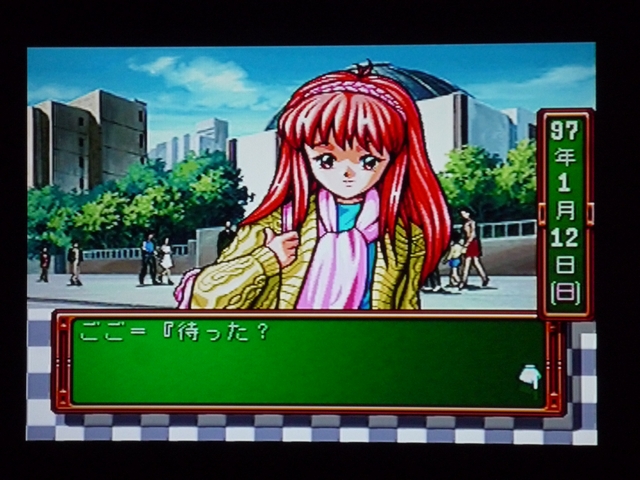 A screenshot from one of the Tokimeki Memorial games
A screenshot from one of the Tokimeki Memorial games
Princess Maker was a “nurturing game”, in which the player has to take care of a child and raise her. On the other hand, Tokimeki Memorial was a dating simulator. Both games were immensely popular, and brought in two major innovations. The first is that they allowed for a new kind of relationship to the bishoujo, one that would be based on interaction: you weren’t just reading manga or watching anime, or even making your own doujin, but you were actually talking to and making decisions for/with the fictional character. The emotional relationship this established was completely different. The other new element is that bishoujo were now grasped in terms of options and statistics: in dating sims especially, you had to choose or navigate between different girls, and each one had different characteristics and abilities. In other words, the player was invited to make choices, to favor one type of character over another, and to analyze the girls in terms of their abilities and distinguishing traits.
This video game logic quickly made its way into anime, as is clear from the three major SF love comedies of the 1990’s: Irresponsible Captain Tylor, Neon Genesis Evangelion, and Martian Successor Nadesico. Of course, each one of these shows is much more than a love comedy, but in the context of bishoujo aesthetics, they all share two characteristics: they clearly target an otaku audience; and in them, the main male character is surrounded by at least 3 female potential love interests, each one with a different personality or “character type”.
Although this logic predates these three shows (see Tenchi Muyô, arguably the first harem anime proper) Evangelion in particular triggered a boom, what was called by some a social phenomenon. Its most popular character was no doubt Rei Ayanami, who was not just a quintessential bishoujo, but popularized a new character type: the kuudere (although the word didn’t exist yet), i.e. the shy, silent and mysterious girl. Unlike the rash Asuka (quickly reinterpreted as a tsundere), Rei’s submissive personality made her even cuter and more attractive. Taking the place of Lum and Minmay from Urusei Yatsura and Macross, Rei became the new icon of 90’s otaku culture and was quickly nicknamed “The Premium Girl” by the media. Patrick Galbraith sums up quite well the consequences of the Eva boom:
“Following the Tokimeki Memorial boom, Neon Genesis Evangelion touched off a subsequent explosion of anime focusing on cute girl characters, overlapped with the bishoujo game revolution, and accelerated content crossover. Amid all this, character love ceased to seem as strange as it once had.” [Galbraith 2019, p.119]
Another forgotten factor in Evangelion’s popularity was the Internet: indeed, Gainax launched its own website just as the series started airing, which in turn favored interaction with the spectators who could react directly to the episodes as they came out. The quick development of message boards allowed for the emergence of a new word to refer to the new kind of affection fans felt for characters such as Rei: that was moe.
Initially, fans would use expressions such as moe moe or moeru moeru to express their affection for characters. There, they used the verb 燃える, meaning to burn or to get fired up, which can refer to love or sexual desire. However, computers would often automatically convert the kana characters not into the “fired up” verb, but instead in 萌える, pronounced the same way, but which means to bud or to sprout. With time, the original kanji was lost, but this etymology is interesting because it reproduces the duality that had already been present in lolicon. Indeed, the first meaning of moeru would translate to the “dark” side of lolicon, oriented towards sexuality and pornography, whereas the second meaning is more innocent and rather indicates a fuzzier, more affective kind of feeling.
Whereas lolicon had been a product of doujin and convention culture, moe was therefore born out of video games and message boards. But the differences ran deeper: lolicon was just another name for the bishoujo aesthetic, and this aesthetic never stopped existing. In a way, we are still in the lolicon boom, even though the word lolicon has disappeared and the design tropes of the bishoujo have changed. What made moe really new was its affective dimension: in the 80’s, there was no specific word to refer to the feelings one had for fictional characters, whereas it did exist from the 90’s onwards. Basically, the phenomenon had become important enough to warrant a new specific word being created.
Moe as interaction
The next major development of the post-Eva era naturally once again took place in bishoujo video games and would be the concept of nakige, that is “crying games”. The origins of this sub-genre of bishoujo games can be found before Evangelion in works such as Classmate in 1992 and, not long after, in Kizuato and To Heart in 1996 and 1997. However, the word only appeared in 1999, when video game company Key released their game Kanon, quickly followed up by Air and Clannad in the following years. The writer behind the three games, Jun Maeda, explained how the idea came out:
“I think the reason that these three works have attracted so much attention is because they are emotionally moving stories. I don’t think any other producer has come up with games that have such an intense range of emotions. Key’s works amp up the emotions to the greatest possible level. I guess that’s why our games are called crying games, because they move players to tears. In the 1990’s, there were moving and heartwarming games, but it was more like players would sit back, nod, and say ‘This is a situation when I could cry.” Playing the games that we make at Key, people actually cry.” [quoted in Galbraith 2014, p.104]
istudistuMaeda’s account focuses on one aspect: the idea that, with crying games, the relationship to fiction and characters moved from an essentially intellectual one to an emotional one. But there was another, more important shift: the pornographic aspect of bishoujo games, one of the fundamental aspects of the genre, was starting to disappear. Indeed, as their name implies, crying games were not played for sexual, but for emotional release. The confirmation of this comes from the very marketing of those games: whereas Kanon and Air had two separate releases, one uncensored and one censored, the third of Key’s major games, Clannad, had only one, that contained no sex scenes.
Clannad may have been one of the symptoms of an apparently increasing divide between the sexual and non-sexual side of the bishoujo aesthetic. Indeed, the “dark”, pornographic side of it had, as I mentioned, always been there, and had always contained graphic, deranging material. But things only seemed to go further as time went by: on the one hand, moe characters in anime and manga works aiming at a wider audience got more and more cute and innocent, but on the other, pornographic depictions only got more graphic and detailed. In other words, otaku material was getting more and more fetishistic, if not outright disturbing and violent. The development of the internet no doubt played a large part, as more and more material could circulate: in this context, the best way for artists and fans to distinguish themselves was to be even more radical in their works. This in turn would have created a vicious cycle, where only hardcore fans would have enjoyed such content, which would then itself get even more niche and disturbing.
One of the fundamental aspects of the lolicon boom and the general bishoujo aesthetic had always been the distinction between reality and fiction: as many scholars have argued [Saitou 2011; Galbraith 2019; Azuma 2009], one of the major selling points of bishoujo was their fictionality. With crying games, the line between reality and fiction was getting more confused, as interactions with fictional characters began to provoke real feelings and tears. This isn’t to say that there was a confusion between reality and fiction, as if otakus were starting to mistake real and fictional girls; but rather that what was called “the 2d world” was beginning to take a reality of its own. And the best indicator of this reality was the feeling of moe.
It’s also important to stress that the interplay between the 2d and the 3d world that’s so characteristic of moe was accompanied by a more intense interplay between mediums. Until the 90’s, bishoujo aesthetics had only two major mediums: manga and anime. But the decade, and most importantly the turn of the millenium, saw the popularization of two new major platforms: video games and light novels. This effectively doubled the number of ways a single story could be experienced and the ways one could interact with characters.
The best example of that is probably one of the most important actors of both the light novel and moe boom of the early 2000’s: the Haruhi Suzumiya franchise. The original light novels were published in 2003, followed by a manga adaptation in 2005 and a first anime season in 2006. Many games also started being released from 2008 onwards. What interests me here is a famous stunt pulled by anime studio Kyoto Animation, that released the episodes of their adaptation in a non-chronological order, starting by the end of the story rather than its beginning.
This is often presented as a boldly experimental move from one of the rising stars of anime at the time. There’s some of that, but also much more: put in direct terms, it was no more than a genius marketing move. Indeed, there was no linear narrative in the anime release, which left viewers with only two possibilities: either construct it by themselves, something they were surely fond of as the otaku they were; or simply buy the original light novels or manga to understand just what was going on. Basically, the anime oriented its audience towards the other versions of the story, not just for the financial aspect of the thing, but to invite them to build their own narratives in the context of various retellings of a similar plot. It pointed to the necessity of a complex relationship with fiction, where just one version of Haruhi wasn’t enough to get the entire picture. With Haruhi, fandom was not just absorbing material, or even interacting with it: it had become much more – building your own world, and performing your own worldview, that of the otaku.
To sum up, since the early 1970’s, otaku culture has largely revolved around one thing: the bishoujo character. In its first incarnations, it was the result of the lolicon aesthetic, that had emerged from shoujo manga. But its shoujo roots quickly disappeared, and this enabled lolicon to expand and become ubiquitous in anime and manga, to the point that even when it faced a crisis in the early 90’s, bishoujo characters would keep thriving not just in anime and manga, but in new mediums such as video games and light novels. This mutation didn’t just mean a widening of the scope of otaku activities: it profoundly changed them and their underlying logic, as the emergence of the concept of moe illustrates. Strong affection for fictional characters had always existed, but moe gave them a name and a consistency that they didn’t have before.
Now, the question is: is there a new change in the works? I’ve argued elsewhere [Watzky, 2020] that the logic of moe has now expanded far beyond otaku circles, and that it can be construed as a major concept of international meme cultures. Besides this, if we stay in Japan, it seems that bishoujo are here to stay: we’re not out of the boom triggered by a few doujin artists back in the 70’s. The two notable evolutions are the internationalization of otaku behaviours beyond Japan, and the continuous appearance of new mediums such as gacha games or vtubers. Although very different, these two new medias seem to indicate yet new directions for the bishoujo. For vtubers, it isthe distinction between 2d and 3d gets even blurrier. For gacha games, it is the object of affection which seems to get thinner and thinner: pure appearances, and barely real characters anymore. Whether this will trigger any real and deep mutations, only time will tell.
Bouvard, Julien, and Mathieu Triclot. 2019. ‘“Les 17 Ans Éternels”: Apprendre à Jouer à Clannad’. In Jeux Vidéo et Adolescence, 149–76. Presses de l’Université de Laval. https://www.academia.edu/42882583/_Les_17_ans_%C3%A9ternels_apprendre_%C3%A0_jouer_%C3%A0_Clannad
Crawford, Rose. 2020. ‘Article: The Castle of Doom and the Lolicon Boom’. The Gonzo Brigadoon (blog). 3 May 2020. https://crawfordpro.wordpress.com/2020/05/03/article-the-castle-of-doom-and-the-lolicon-boom/.
Galbraith, Patrick. 2014. The Moé Manifesto: An Insider’s Look at the Worlds of Manga, Anime, and Gaming. Tuttle Publishing.
Galbraith, Patrick. 2019. Otaku and the Struggle for Imagination in Japan. Duke University Press.
Kinsella, Sharon. 1998. ‘Japanese Subculture in the 1990s: Otaku and the Amateur Manga Movement’. Journal of Japanese Studies 24 (2): 289–316. https://doi.org/10.2307/133236.
Saitou, Tamaki. 2011. Beautiful Fighting Girl. University of Minnesota Press.
Takeuchi, Kayo. 2010. ‘The Genealogy of Japanese “Shōjo Manga” (Girls’ Comics) Studies’. US-Japan Womens’ Journal 38: 81–112.
Watzky, Matteo. 2020. ‘Postmodern Media : Memes and Database Consumption’. Animétudes (blog). 3 May 2020. https://animetudes.com/2020/05/03/postmodern-media-memes-and-database-consumption/.
Like our content? Feel free to support us on Ko-Fi!
You might also be interested in
Oshi no Ko & (Mis)Communication – Short Interview with Aka Akasaka and Mengo Yokoyari
The Oshi no Ko manga, which recently ended its publication, was created through the association of two successful authors, Aka Akasaka, mangaka of the hit love comedy Kaguya-sama: Love Is War, and Mengo Yokoyari, creator of Scum's Wish. During their visit at the...
Benoît Chieux, a career in French animation [Carrefour du Cinéma d’Animation 2023]
Aside from the world-famous Annecy Festival, many smaller animation-related events take place in France over the years. One of the most interesting ones is the Carrefour du Cinéma d’Animation (Crossroads of Animation Film), held in Paris in late November. In 2023,...
Do anime events have room for creators? – Interview with Koji Takeuchi
The Annecy International Animation Film Festival is a place of many little pleasures, and one of them is to meet with Kouji Takeuchi, a pillar of the anime industry, and learn a little bit more of Studio Telecom's lore, which you can read more about in our previous...

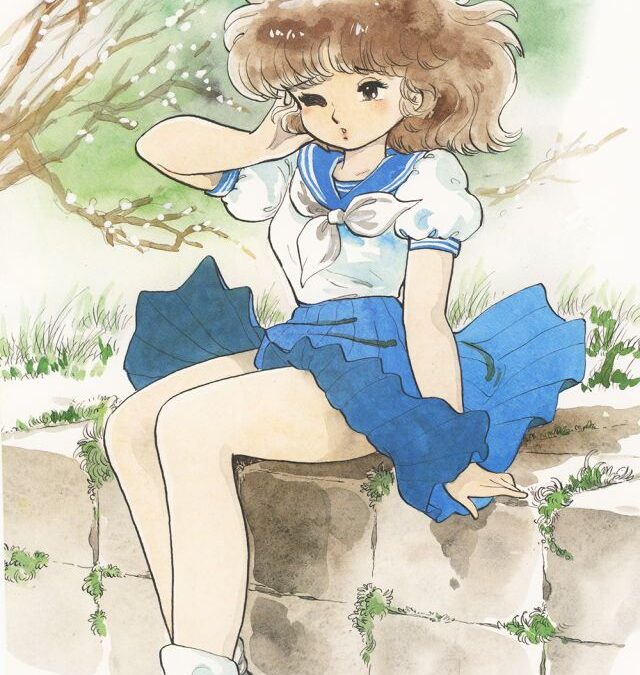
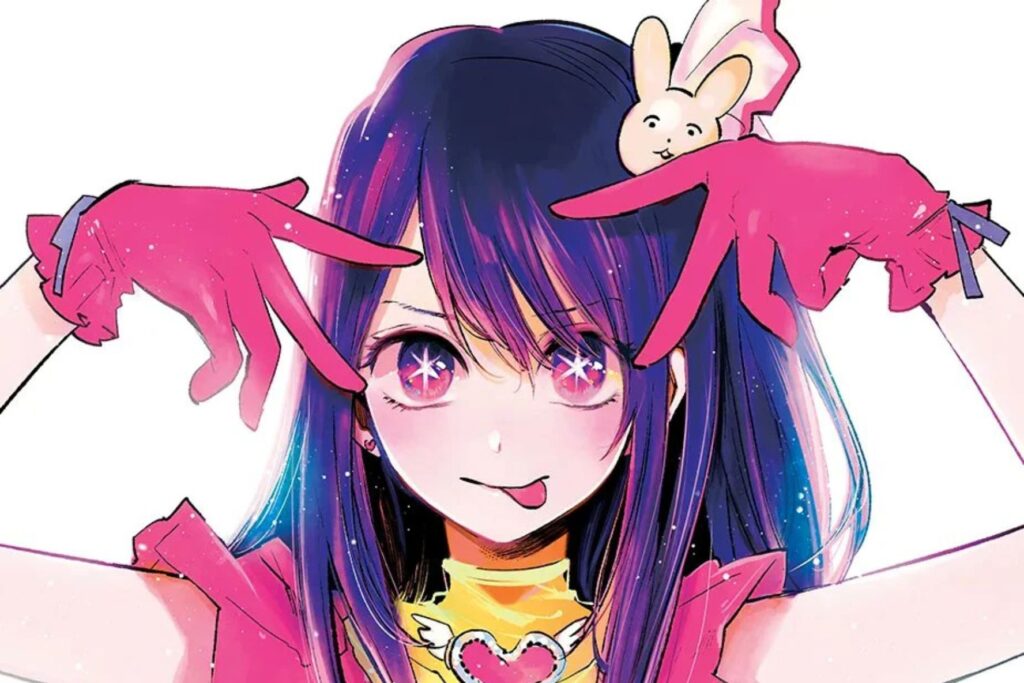

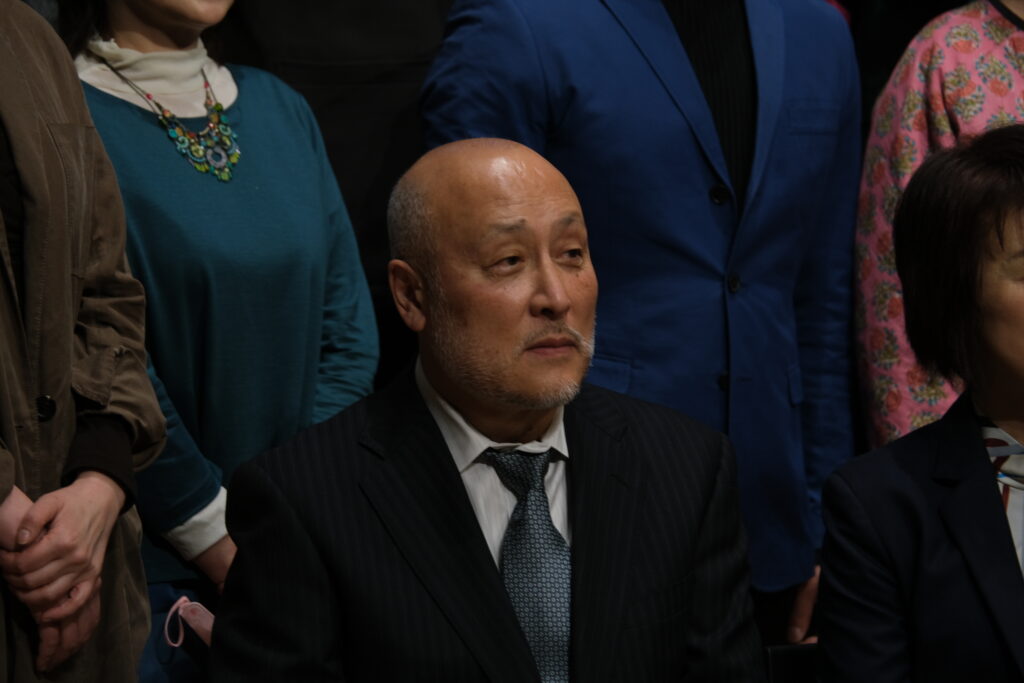
I read through your article. Though I’ll need to do a more thorough reading in the future to decide whether to recommend this to western anime fans interested in Japanese anime and manga history.
A couple things.
>>many suspicions that most anime tapes were in fact planted by journalists
Did any of your sources label the Lolicon video tape titles?
I noticed this mentioned in another western blog about Miyazaki, but Japanese sources don’t talk about any Lolicon anime tapes. Most of the tapes Miyazaki had were normal anime like ‘男どあほう甲子園’ (a popular baseball manga for boys) and ‘ドカベン’ (another popular baseball manga for boys). The only thing that was weird about the tapes was that he had so many of them and various VCRs; a glance at a distance was enough to conclude Miyazaki was a maniac. The focus on tapes with violent movies were the mass media grasping at straws.
What was suspected of being planted were a pile of Lolicon manga magazines that WERE the focus of photographs to highlight the evil manga that influenced Miyazaki. The books stood out because they were very recent releases, as if someone bought them around the same time the police were entering and leaving the bedroom, though the one that was always a focus among the pile was a normal Gekiga Ero-manga called ‘若奥様のナマ下着’, which wasn’t Lolicon, but nevertheless created a discussion on whether it was Lolicon due to it being in Miyazaki’s bedroom.
Coincidentally enough, it turns out those books were indeed planted in Miyazaki’s bedroom by Kobayashi Toshiyuki (小林俊之), who admitted to it in his book released in 2015 (前略、殺人者たち 週刊誌事件記者の取材ノート) and in an interview with Vice Japan. He said he did it so the newspapers could get a ‘good picture of a criminal’s bedroom’.
>>While “lolita” implies a prepubescent girl
The word has never really implied a prepubescent girl. Even when Azuma Hideo defined Lolita Complex in Cybele, he defined a Lolita between the ages of 12~15 along with two other kinds of complexes that Lolita Complex would inevitably vacuum up. This understanding has remained mostly consistent through the 80s and 90s; you’ll see a Lolita character drawn by Uchiyama Aki and he’ll write in her profile that she’s 15; it’s why all the erotic games featuring uniformed girls were interchangeably called Bishoujo and Lolita games in Japan.
I personally don’t know how westerners were introduced to the term through Japanese media, and how it has come to exclusively imply a prepubescent girl exclusively in their minds, but trying to investigate the western internet is much harder than the Japanese one.
Thank you for your detailed and insightful comment!
I’m especially thankful for the precisions you bring on Miyazaki’s tape collection – none of the English-speaking sources I used detailed precisely what it contained, except for the pretty general kind of material I mentioned in the article.
As for the “lolita” word, I went for the general Western perception of it, which I assumed was that of the reader – a young girl just before or at the very start of puberty. But your precisions are very much on-point!
Could you link to that Vice interview? Sounds interesting.
I would also like to add in my own input about Year 24, although Riyoko Ikeda debuted around the same time as them she was not a part of the group, they were a clique of friends that lived in the same neighborhood in Oizumi, hence why they called themselves Year 24 group and the Oizumi Salon.
The Year 24 group is not necessarily limited to the members of the Ōizumi Salon (which by the way, was an actual apartment that many members shared, not just a neighborhood where they lived near each other). For what it’s worth, Rachel Thorn has included Ikeda within the scope of that designation before. Kayo Takeuchi, cited in this blog post, does as well.
Thank you for the interesting and informative article.
This is a pretty good overview of lolicon and moe, and you have some interesting ideas yourself (like the concepts of “light” and “dark” aspects). That being said, although the broad strokes are pretty correct, I couldn’t help but notice some inaccuracies and some claims that may be up to debate. I hope you’ll forgive me for going into them.
I don’t know if the taste for shõjo manga was frowned upon in the ‘70s, and especially among other manga fans. Takekuma Kentarō writes that “Back then, a man who identified as a manga fan, but didn’t read shōjo manga, was basically considered to be unqualified.” (quoted in Nagayama Kaoru, Erotic Comics in Japan/Eromanga Studies) Nagayama himself writes, “For men who identified as manga fans, works by Hagio Moto, Takemiya Keiko and other Magnificent 49ers were an absolute must, but if you were a real fanatic, then you would get into Okada Fumiko…” and goes on. This part of Nagayama is actually cited in Galbraith, which you cite.
Also, don’t forget that the work of the Year 24 Group included SF (for example, Terra e)—so it wasn’t necessarily in opposition to SF.
Since Lemon People is a commercial magazine, I would think the works published inside it wouldn’t count as “dōjin” anymore.
Both Lemon People and Manga Burikko had idol photographs before switching over to only bishōjo manga, but as far as I’m aware, the thing about reader demands (or at least complaints) mostly applies to Manga Burikko. That is, I double checked my sources, and I could only find references to readers complaining about photographs in Manga Burikko.
Nakamori was referring to more than just lolicon fans with the word “otaku.” He may have been focusing on them (and the “Otaku Research” column would go on to exclusively focus on them), but if you look at his first column, he mentions trainspotters, SF fans, techies, Poindexters—a whole host of nerd stereotypes.
I do think you can ascribe some generic/categorical status and possibly a relationship descriptor to lolicon, even in the ‘80s. (Why wouldn’t have people described things like Cream Lemon as “lolicon anime”? After all, Manga Burikko and such were lolicon magazines.) And although you seem to suggest that “lolicon” does not imply affect while
“moe” does, Galbraith writes that many people at the time “understood [lolicon] to be an orientation toward fictional bishōjo.” That is to say, there is an affective dimension or orientation connected to the term lolicon, and that became the affect referred to by the term ”moe.” (Also, even if you write that “there was no specific word to refer to the feelings one had for fictional characters,” the word “two-dimensional complex” was also in circulation in the ‘80s—so although it was not as flexible or as versatile as “moe,” there was indeed a specific word.)
According to Nagayama, the lolicon boom, at least in commercial eromanga, declined in the mid-80s. (Perhaps Nagayama is thinking of the proportion of lolicon manga vs. non-lolicon manga being published.) Galbraith seems to follow Nagayama by putting the end of the “boom” proper as 1984. Of course, lolicon works were made after then, but perhaps that cutoff of 1984 means that it once again became a subcultural thing, rather than being mainstream.
Although I think I know what you’re getting at when you say this, the word “lolicon” has certainly not disappeared. (Nor have lolicon works—although they may be a minority of commercial works, lolicon is currently Toranoana’s second top-selling category of male-oriented dōjinshi, according to their Seiheki Terminal portal.) Maybe “gone underground” is a better description?
The structure of the piece makes it seem like the word “moe” came out of Eva fandom—but Galbraith, citing Morikawa Ka’ichirō, writes that the word emerged in the early ‘90s, before Evangelion. Indeed, although Evangelion was certainly key in the spread of moe, the discourse around it was not the origin of the concept moe itself or its use in fandom.
I think the hyperreality of otaku media (fiction “taking a reality of its own”) existed before bishõjo games. (This is one of Saitō’s core arguments, after all–and Saitō is thinking of an entire genealogy of sentō bishõjo works in anime.) And I think the word “moe” probably developed to describe a kind of affect felt in otaku sexuality from its origins. (I think Galbraith’s argument is for the overall continuity of this kind of affect: from early forms (like Miyazaki falling in love with Bai Niang) to lolicon to moe.)
I wouldn’t necessarily say that the essence of moe is an “interplay of 2D and 3D.” Just because 2D worlds gain a sense of hyperreality doesn’t mean that they interplay with our everyday world. (They can, and this would contribute to what Saitō would say is the pleasure of playing with layers of fictionality and reality, but I don’t think it’s a given.) Rather, doesn’t the “reality of fiction” as itself seem to be a rejection of 3D rather than its interplay?
The part about Haruhi seems to be getting at Ōtsuka Eiji’s theory of narrative consumption, but it’s not quite cited. Maybe you weren’t thinking of it in those terms, but it seems to very much be along those lines to me. (Also, with Haruhi, certainly the LN was a relatively new form, but the media mix itself was not new in the 2000s.) That being said, the part about the non-linear narrative encouraging that narrative consumption is quite insightful!
Sorry for making such a long, nitpick-y comment! Again, I think there’s some ideas here worth exploring further, and I think it’s correct in general terms, but there were those specific points that stood out to me.
Thanks for the extremely detailed comment! I hope you’ll forgive me if I don’t go over all the points you raised.
As for the popularity of shoujo manga in the late 70’s, I confess it’s hard to tell without any other major sources than Galbraith. However, the impression I have is that, indeed, it was popular and considered important reading for manga fans. However, from what I understand, such tastes were not as approved of in the older generations – whether the ones that had grown up on gekiga or the SF fans that had set up the first big conventions. I sadly don’t have enough knowledge of the matter, but I’d be very curious to know how Year 24 shoujo series were received among male otaku fans, as it would indeed be a good indication of how things evolved.
All of what you mention about moe is very interesting and I agree with most of it. My main thesis was, however, that there is, indeed, something new with moe. I think many people (as I think is visible in many interviews making up Galbraith’s “Moe Manifesto”) tend to just apply moe to earlier engagements with fictional characters. Of course “moe” as a specific phenomenon grew out of it, but in both range and degree, I’d be tempted to say that there’s still a clear evolution. But the idea that there’s “continuity” in this affect, as you say, seems very correct to me, and it’s not restricted to anime/manga-focused fandoms – the same could apply to idol fans for example.
For the Haruhi bit, I of course had Otsuka (and Azuma) in mind, but the article was already long and complex enough, so I had to do without citing them. The media-mix is a related issue, and I do think it’s central to all these questions, but once again, I had to keep things focused.
Thank you again for the detailed discussion, I hope I could make myself understood better!
Really like your stuff, thanks for sharing
>On the contrary, while “lolita” implies a prepubescent girl, shoujo or bishoujo point to an often minor girl that is precisely at the age of discovering her sexuality – from around 13 years old up until the mid-20’s.
Have to respectfully disagree with you there Matteo, the term lolita does not imply prepubescent. Your article cites Clarisse as an example of bishoujo and Clarisse is clearly not prepubescent (she has breasts) and Lupin calls the Count a lolicon for wanting to marry her.
Loli and Bishoujo were synonynms at the time, you see the same thing in 1982 with Urusei Yatsura – a teacher is described as suffering lolicom when he’s pining for Lum, a busty highschooler.
The girls in “Lolita Anime” series of the late 80s all have breast development, even the 5th-graders in Hell Teacher Nube have noticeably large breasts when the school doctor gets called a Lolicon in 1996 for wanting to give them physicals.
The idea that lolita or loli implies PREpubescent or PREteen girls (to the exclusion of mid-pubescent or teens) is basically a forced meme born in western 4chan around 2004 which we first see exhibited in Danbooru’s wiki in 2005.
The idea that 13 is “too old” to be a loli isn’t seen until 2014, and that’s only in the context of high-school boy characters saying what’s loli, which makes sense in respect to them since they are not middle-aged men. The only younger girls highschool boys have a significant age difference with is middle-schoolers, not fellow high-schoolers like Lum or Clarisse.
Westerners are completely ignoring context of usage and the broadness of usage in Japan. It’s a travesty.